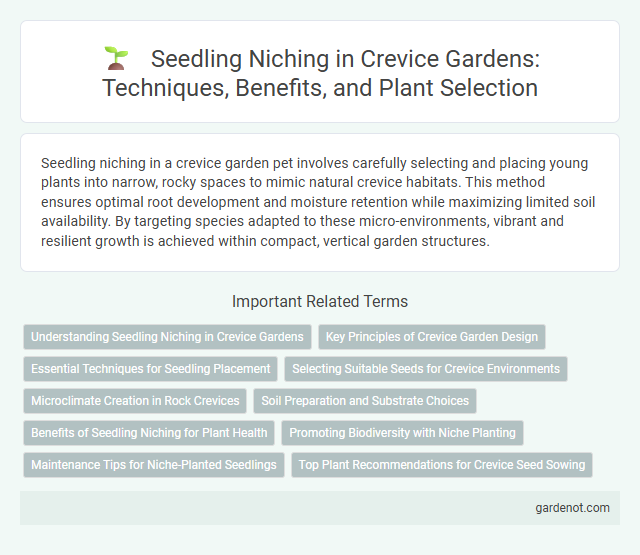Seedling niching in a crevice garden pet involves carefully selecting and placing young plants into narrow, rocky spaces to mimic natural crevice habitats. This method ensures optimal root development and moisture retention while maximizing limited soil availability. By targeting species adapted to these micro-environments, vibrant and resilient growth is achieved within compact, vertical garden structures.
Understanding Seedling Niching in Crevice Gardens
Seedling niching in crevice gardens involves selecting plant species that thrive in the narrow, nutrient-poor fissures mimicking natural rock habitats. Understanding the micro-environmental conditions, such as moisture retention and sunlight exposure within these crevices, is essential for successful seedling establishment and growth. Proper seedling niching enhances biodiversity and resilience in crevice gardens by promoting species adapted to extreme growing conditions.
Key Principles of Crevice Garden Design
Seedling niching in crevice garden design emphasizes creating narrow, deep gaps that simulate natural rock fissures, allowing seedlings to establish roots in well-drained, mineral-rich substrates. Key principles include selecting suitable rock types, constructing diverse crevice depths to accommodate various plant sizes, and ensuring optimal sun exposure to promote healthy growth. These design elements foster microclimates that enhance seedling survival and mimic alpine habitats.
Essential Techniques for Seedling Placement
Precise seedling niching in crevice gardens ensures optimal root development by placing seeds in narrow soil pockets mimicking natural rock fissures. Essential techniques include selecting appropriate soil mixtures that retain moisture while allowing drainage and positioning seedlings at depths tailored to species requirements to promote stability and nutrient absorption. Incorporating microclimate factors such as light exposure and airflow enhances seedling survival and robust growth in this specialized horticultural setup.
Selecting Suitable Seeds for Crevice Environments
Selecting suitable seeds for crevice gardens involves choosing hardy, drought-tolerant species that thrive in minimal soil and limited moisture conditions typical of narrow rock fissures. Alpine and rock garden plants such as saxifrage, thyme, or sedum excel in these microhabitats due to their compact root systems and adaptability to nutrient-poor substrates. Seedlings must be carefully nurtured to establish in crevices where water retention is low and sunlight exposure varies, ensuring successful growth in these specialized environments.
Microclimate Creation in Rock Crevices
Seedling niching in crevice gardens leverages the unique microclimate created by rock formations, which offer temperature regulation, moisture retention, and protection from wind. These microhabitats enable delicate seedlings to establish by reducing environmental stress and enhancing humidity around their roots. Optimizing crevice angles and depth enhances these benefits, promoting higher survival rates and biodiversity in rock gardens.
Soil Preparation and Substrate Choices
Seedling niching in a crevice garden requires precise soil preparation to simulate natural crevice conditions, emphasizing well-draining, nutrient-poor substrates like sandy or gritty loam mixed with organic matter. Optimal substrate choices include a blend of coarse sand, perlite, and small gravel to ensure excellent drainage and aeration, preventing root rot and fostering healthy seedling establishment. Adjusting pH to slightly acidic or neutral levels further supports niche-specific seedlings adapted to crevice environments.
Benefits of Seedling Niching for Plant Health
Seedling niching in crevice gardens improves plant health by creating micro-environments that regulate moisture and airflow, reducing the risk of fungal diseases and root rot. This targeted planting technique enhances nutrient uptake by minimizing competition among seedlings, promoting stronger root development. Optimized seedling spacing also boosts resilience against pests and environmental stress, leading to healthier, more vigorous plants.
Promoting Biodiversity with Niche Planting
Seedling niching in crevice gardens enhances biodiversity by mimicking natural microhabitats that support diverse plant species. Niche planting creates microclimates and soil variations within narrow cracks, facilitating the growth of specialized flora adapted to specific moisture, sunlight, and nutrient conditions. This targeted approach increases ecosystem resilience and encourages a balanced habitat for pollinators and beneficial insects.
Maintenance Tips for Niche-Planted Seedlings
Crevice garden seedlings benefit from well-drained, nutrient-rich soil to prevent root rot and encourage strong growth. Regularly monitoring moisture levels ensures seedlings do not dry out or become waterlogged, which is critical in narrow, rocky crevices. Applying a balanced, slow-release fertilizer during early growth stages supports healthy development and resilience against stress factors common in niche planting environments.
Top Plant Recommendations for Crevice Seed Sowing
Ideal top plant recommendations for crevice seed sowing include hardy, drought-tolerant species such as thyme (Thymus spp.), saxifrage (Saxifraga spp.), and alpine phlox (Phlox subulata). These plants thrive in narrow soil pockets, establishing strong root systems suited for the minimal soil depth of crevice gardens. Selecting these species enhances plant survival and garden aesthetics in challenging crevice garden environments.
Seedling niching Infographic

 gardenot.com
gardenot.com